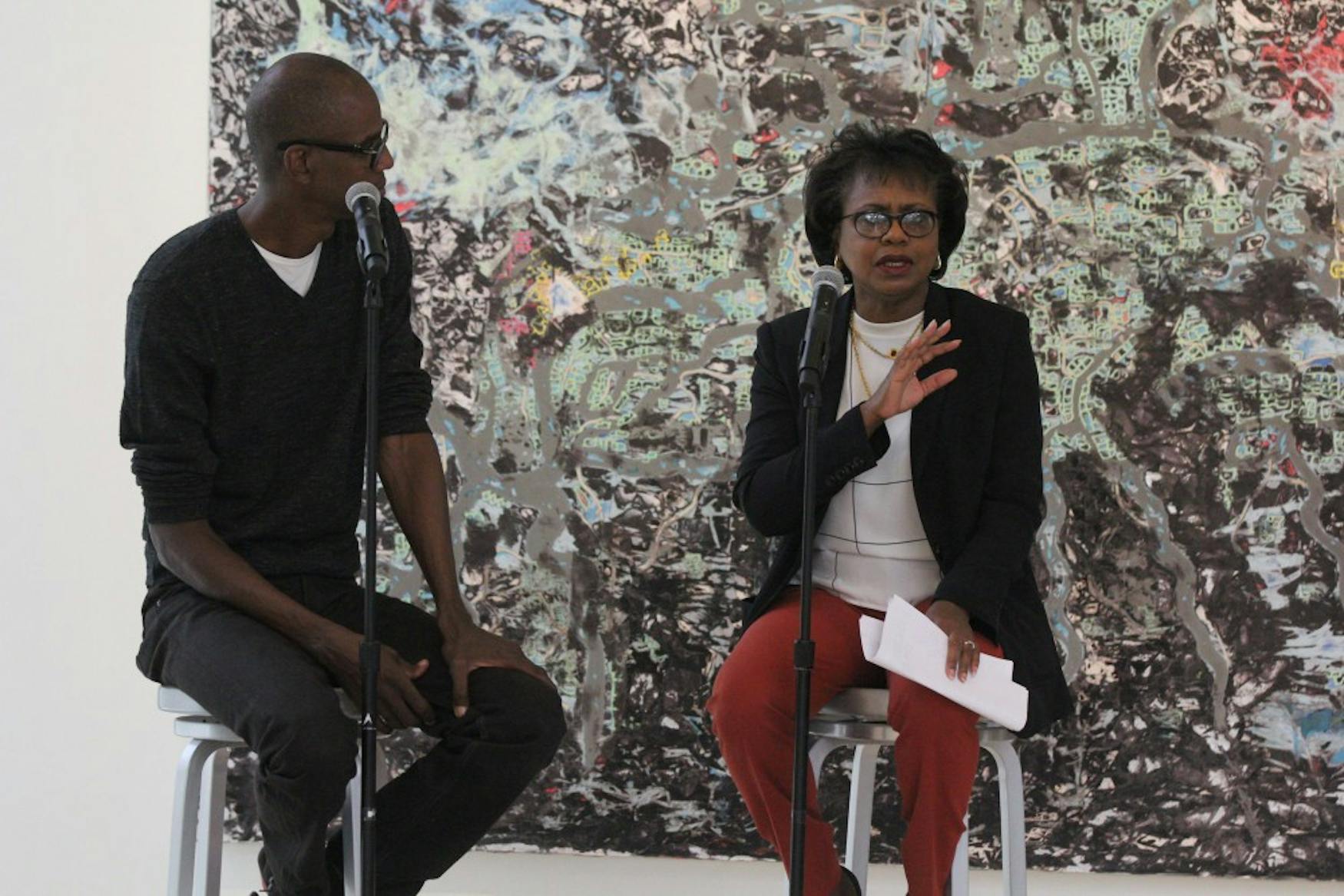Bradford and Hill discuss art and society
A pairing of one in a million; abstract artist Mark Bradford and Prof. Anita Hill (Heller) spoke together on Friday afternoon, discussing art in a societal context. The two met in the Henry and Lois Foster Gallery of the Rose Art Museum where Mark Bradford’s exhibit Mark Bradford: Sea Monsters is currently housed. The event was part of the Art Blackness Diaspora program, presented by the department of Fine Arts, the department of African and Afro-American Studies and the Rose Art Museum. Funding for the program comes from the Brandeis Arts Council.
Rows of seats lined the square-shaped first floor of the Museum, all facing the right back corner where Hill and Bradford sat in front of one of Bradford’s large canvas paintings, “Sea Monster” (2014).
Chris Bedford, director of the Rose Art Museum, started off with an open question to both of the speakers and, from there, let Bradford and Hill engage in an open discourse with each other. Bedford asked about how we narrate history—the difference between a liner and a messy version of narration and which one is preferable. To this, Hill stated boldly and somewhat jokingly, “Everyone knows about my messiness.”
The conversation then got serious as Bedford and Hill discussed their respective and, one could argue, messy paths to getting to where they are today. Hill talked about how she never envisioned being a professor. “I really had no intention of teaching at Brandeis about social justice,” she said. She was on a path to be a lawyer when she decided to work in academia.
Bradford had a similarly non-linear track. He talked about wanting to be a flight attendant in high school. Bradford lacked access to many resources; he said that he had never even heard of the SAT and had no huge prospects for his future. When he realized he was going to be 6’8”, it was clear that his dream of being a flight attendant wasn’t going to work out. So he became an artist.
Hill expressed her admiration at what a brave decision Bradford had made in deciding to go into art. “No, no, no. No brave,” Bradford said, seemingly flustered by Hill’s comment. He talked about how working in his mother’s hair salon growing up, art was always part of his life. Bradford explained that the creativity in his paintings is just a continuation of his childhood days arranging wigs and writing on signs the different services in fancy fonts.
Hill asked Bradford what he learned from the women in the hair salon, which started a longer conversation about his childhood experiences there. “They dealt with the good and the bad with dignity,” he said.
Hill then shifted to asking Bradford about his work for a nonprofit group, The RightWay Foundation, an organization that works to provide foster children with mental health resources and career opportunities. The foundation actually works from within Bradford’s mother’s old hair salon. He talked about how the participants in the program resembled himself as a child—these are the same students who, like him, did not even know what the SAT was.
Bradford said his goal in working with the organization was to help create a “safe space where [the participants] can be vulnerable, without the public hearing about them as foster kids.” Bradford encouraged other artists to pair up with organizations in the outside world. He noted that the art world has a lot of great ideas, and the outside world has a lot of people. With that combination, he said, something great could happen.
A question-and-answer segment followed the talk. The three audience members who asked questions were actually all artists. They asked Bradford about his artistic career and some sought advice for their own. Bradford’s main piece of advice to artists was not to be artificial and to go with whatever happens. “I don’t make the work that I should make. I don’t say the things that I think I should say,” he said. It is clear that Bradford has embraced the messiness.



Please note All comments are eligible for publication in The Justice.